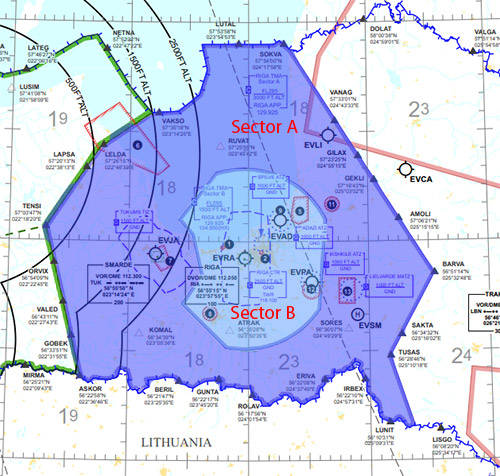2019 January
Sector file data updated to include new SID procedure identifiers. SMR updated once again with taxiway and IHP changes, stand lines extended on apron 3 (west side). Frequencies updated in advance of changes in next AIRAC publication (Riga Tower 118.100 -> 118.105; Riga Ground 118.800 -> 118.805). Due to VATSIM limitations, this will just be a change in ATC spoken procedure, not actual used frequencies.
New: From this year, the Tower controller will no longer speak the frequency of Approach controller with a take-off clearance. Instead, it is the pilot’s responsibility to switch to EVRA_APP (or EVRA_B_APP if online) before passing altitude 1,500ft (or as soon as is reasonably practical). Please ensure you are following this procedure which has been published in AIP and every chart for some years already. In addition: if you receive no instructions after landing, switch to Riga Ground (118.805) when runway vacated.
2018 April
Charts were updated to the latest cycle. New sector files were published, which include realistic ground view layout and SMR system, TWR view layout updated to reflect changes in the CTR reporting points for VFR traffic.
2017 November
Website Briefing and ATC Training pages updated, and updated radio telephony guide revised and published.
2017 October
EVRR Sector file updated to reflect new stand numbers coming in AIRAC 1712 cycle (AMDT 010/2017) on Apron 2. ATIS files updated to reflect the real world syntax and released as a separate package on GNG. Charts for Riga and Ventspils updated, enroute charts updated, and FRA charts added. New scenery was released for EVRA, compatible with P3D v3, P3D v4, and X-Plane 11. Download information can be found on the scenery page.
2017 September
EVRR Sector file updated for a new test version which includes an updated ground layout to match the real world status of the airport currently. While this is now 100% up-to-date, most scenery versions are a little behind, but the controllers are aware and ready to help. The freeware X-Plane scenery version available should match up with it 100%.
2016 December
EVRR Sector file AIRAC 1604 released, with inclusion of updated Malmo sector frequencies, fixes to bugs in ATIS files, inclusion of Ventspils ATIS, and other minor bug fixes. Download latest sector file here.
2016 October
Riga Intl. (EVRA) aerodrome and Heliport charts are updated. En route charts are also up to date.
2016 June
EVRA ATIS audio files are added in download section;
EVRA ATIS is 120.170Mhz;
Statistics for traffic and ATC updated here.
Week 5 2015 Iron Mic’ achieved by EVRA TWR!
Week 4 2015 Iron Mic’ goes to EVRA TWR and APP, EVRR CTR took 2nd place!
ATC / Traffic statistics section avail here.
BALT_CTR new frequency is 132.300Mhz. (Prev. was 132.320) Effective Sept 01.Y16.
EVLA ATIS Removed. Effective Sept 01.Y16.
Iron Mic’ award 5 times in a row goes to EVRR CTR, thanks to vACC’s most active ATCO A.Grocevs!
Also Riga TWR won Iron mic for OCT week 41!
2015 September/ October
All aerodrome and Heliport charts are updated.
BALT_CTR new frequency is 132.300Mhz. (Prev. was 132.320)
EVRA ATIS new frequency is 120.175Mhz.
EVLA ATIS Removed. Effective Sept 01.
Iron Mic’ award goes to EVRR CTR, thanks to vACC’s most active ATCO A.Grocevs!
2014 APRIL 03
Procedures for planning and execution of training flights at Riga aerodrome are added in Briefing section.
New, updated EVRA, EVAD Visual approach charts, effective April 03.
Changes: North transit route (MAJORI- KALGALE), CTR entry points DOLE, KALNGALE and MAJORI added, VISTA and PARKS removed ,holding EAST changed.
2014 MARCH 25
Riga International airport (EVRA) now has dedicated FS9 and FSX scenery.
Riga Appraoch (EVRA_APP) received 3rd in a row Iron Mic’ Award for week 11. Congratulations!
Aviation weather (METAR, TAF, SIGWX Chart, Surface WX, Pressure chart) for local region and Europe is available in Pilots section.
2014 March
All Charts and scenery are up to date.
Iron Mic’ award for the second time goes to EVRA APP!
2014 MARCH 06
All Charts are up to date.
2013 MARCH 31
Starting with AIRAC 1304, effective 04 April 2013, a new ATC position is introduced in Riga TMA.
Until this time, Riga TMA consisted of two sectors – A and B, but they were controlled by a single position – Riga Approach (EVRA_APP) on 129.92. Now during high traffic loads or at ATC discretion it can be separated in two positions – sector A (the bigger one) remains controlled by EVRA_APP, and sector B – by Riga Approach (EVRA_B_APP) on 134.85. Also lateral limits of sector B have changed a bit (see the map below; before that it was 25nm circle around RIA VOR).
Note that both positions share the same callsign – Riga Approach.
This is how those sectors look laterally:

And vertically:
If both APP positions are online, their duties are separated as shown above.
If there is only EVRA_APP online, it controls both sector A and sector B (as it was before).
Normally EVRA_B_APP should not be online alone, but as it might happen in Vatsim, it will be left to controllers discretion, if he also assumes control of sector A.
In typical operations, arriving aircraft can expect STARs in EVRA_APP and vectoring in EVRA_B_APP, but it might be different depending on traffic situation, controllers preferences or pilot request.
Phraseology
On initial contact with EVRA_APP, report:
- callsign
- latest ATIS letter
- instructions received from previous ATC unit (STAR, heading, level, etc)
Example: Riga Approach, Air Baltic 123, information E, LAPSA 5A, descending FL090
When changing from EVRA_APP to EVRA_B_APP, only state your callsign.
Example: Riga Approach, Air Baltic 123
